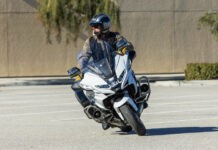As a solo and two-up sport tourer of many moons, in my experience there are two mistakes many canyon strafers make more often than most. No. 1 is hugging the centerline in blind left turns. No. 2 is riding over your head in order to keep up with a faster group. I have seen more accidents as a result of these behaviors than I can count, ironic since both are so easy to avoid.
The lure of the centerline is strong, because the actual apex of a left turn is clear across the oncoming lane by the shoulder of the road. In a blind left, though, where you can’t see if there’s a car or a bus coming the other way, the centerline is to be avoided like playing spin-the-bottle with your in-laws. Even if you keep both tires on your side in the turn, leaning into it your head can be as much as 2-3 feet over the centerline. Changing your line midcorner takes time at speed, and you may not have enough of it when that unseen bus comes the other way. Especially if it’s 2 feet on your side.
A better practice on the street—one that I use all of the time, not just in blind turns—is to celebrate lefts by making them longer, stretching them out. I ride on an imaginary line to the right of the center of the lane all the way around. It’s not the fastest way, certainly, but I almost never need to make a mid-corner correction, and when I do it’s usually just a quick tiny one. Surprise oncoming traffic almost never startles me this way and causes a “smoothness interruption,” either, the result of your butt cheeks suddenly clenching the seat and upsetting the bike’s composure.
Another option is sometimes called “late apexing,” in which you also enter the blind left on the far right. Instead of holding that line all the way around, though, as soon as you can see that it’s clear, you simply tighten up the line, apexing a little right of the centerline. This can be advantageous when the next turn is a quick right, for example, and is probably a slightly faster way around, but can require you lower your entry speed a little. By the way, flipped accordingly both of these techniques work for rights, too. You just don’t see as many riders hugging the inside shoulder too closely in blind rights because their head would probably hit the thing that’s making it blind.
Mistake No. 2 is avoided here at Rider with Rule No. 1, which is that everyone must ride their own ride. The main reason the riders in front are so fast is that they know where they’re going, right? If the riders in back don’t, it can lead to them giving chase to avoid getting lost, riding over their heads and taking chances they otherwise would not. Next thing you know, your day is ruined. It’s easy to prevent such a situation and still run a satisfying pace for everyone when several conditions are met: 1) Everyone knows where you’re going and has a map. 2) You have a system for hooking up if you get separated—cell phones often make this much easier. 3) The whole group or each arriving rider waits at intersections for the one behind until the designated caboose shows up. 4) The slowest rider has all the credit cards.
Enjoy the ride!







